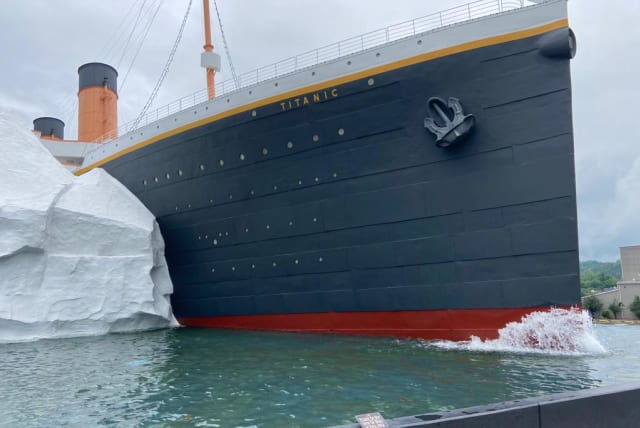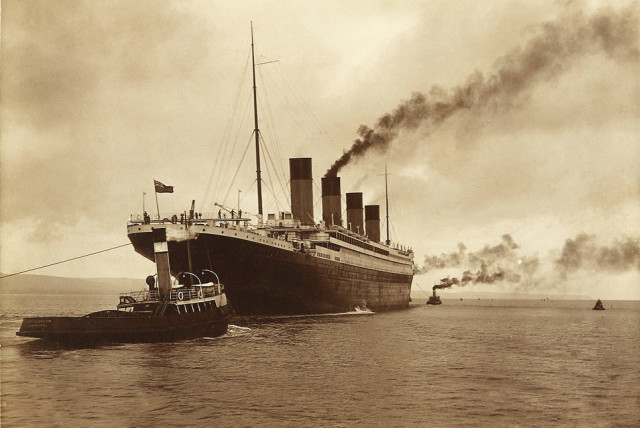Israel is like the Titan submersible: Frail and fragile - opinion

Ben-Gurion was warned repeatedly that should he carry out his pledge to declare statehood, we would be cast into a hostile sea of enemies who would determinedly bang against our hull.
Last summer, my wife and I took a road trip through the southern United States, one of the most historic and beautiful areas of the country. After leaving Nashville, America’s music capital and one of its fastest-growing cities – we drove into a town called Pigeon Forge. Famous for being the hometown of singer Dolly Parton, this tourist center has another major attraction, the Titanic Museum.
Now, let me begin by saying that we are both hard-core Titanic fanatics. I remember, as a little boy, building a model of the great ship and I still have one on my mantle. We have been to the Titanic museum in Southampton – where the vessel began its maiden voyage across the Atlantic – as well as the museum in Queenstown (Cobh, or Cork, Ireland), its final port of call before heading out to sea. We have seen hundreds of relics and photos of the event and, of course, watched James Cameron’s blockbuster film, Titanic, several times.
But the Pigeon Forge installment of the Titanic story is exceptional. To begin with, the entire museum is a gigantic mock-up of the Titanic, including an adjoining massive faux iceberg, mimicking the one that struck the ship’s starboard side just four days into her journey. The museum was built by John Joslyn, who was among the first travelers to the site of the Titanic’s sinking, in 1987, and brought back hundreds of artifacts from the wreckage.
Visitors to the museum can grasp the wheel on the captain’s bridge or tap out messages on the ship’s wireless, but the eeriest experience for us was dipping our hands into a pool of icy water, kept at exactly the same temperature as the frigid ocean into which passengers dived in a vain attempt to escape from the doomed vessel.
Upon entering the museum, ushers wearing authentic Titanic uniforms hand each visitor a “passenger profile” boarding card that tells the story of one of the passengers aboard the ill-fated journey.
Seeing my kippah, the usher excitedly looked through the cards until he found those of Isidor and Ida Straus, the fabulously wealthy owners of Macy’s department store who famously gave up their place in a lifeboat and went down with the ship.
The usher then informed us that a special exhibit was being held called, “Jews of the Titanic,” highlighting all the many Jews who were on the ship, with special emphasis on the Straus couple – there was even a reconstructed model of their “Millionaire’s Suite” – as well as displaying the Titanic’s kosher menu, and recovered dishes and silverware labeled milchig (dairy) and fleishig (meat).
The tragic saga of the Titan submersible
So it goes without saying that we joined the millions of people captivated this past week by the tragic saga of the Titan submersible, which ironically would suffer the same fate as its older and much larger sister ship. Both would perish from damage to their ships’ bodies, victims of nature’s often capricious effect on the fragile workings of man. They now will lay close together forever in the same resting spot, a memorial to both the daring and the danger of adventurism.
Cameron himself commented on the phenomenal measures needed to make hazardous journeys such as these.
“The two most perilous and pervasive environments,” he said, “are deep space and deep oceans.”
Both require gargantuan investments in energy, money and scientific skill, as they challenge the passion of intrepid entrepreneurs determined to blaze new trails and take us to places seemingly out of mortal reach. They stretch our capabilities to the very limit, taking the risk-reward paradigm to its extreme.
The stories of the Titanic and – now – the Titan too, fascinate the world in a way unlike almost all others.
In truth, these are not the first – nor likely the last – instances of ships lost at, or under the sea; countless other vessels have gone down or gone missing throughout the ages.
Israel, too, has had its own under-the-waves tragedy; the Dakar submarine and her entire 69-man crew were lost en route to Israel in 1968. Despite extensive searches over the course of three decades, its wreckage was not found until 1999 when it was discovered between the islands of Cyprus and Crete thanks to advanced technology of the type that would later locate the Titanic
But there is something unique about Titanic that touches the masses, some intangible that seizes our attention and will not let it go. It may be the grandeur of this vessel that boasted state-of-the-art accommodations for the upper crust and provided a “Ship of Dreams” that we could all at least fantasize about.
Maybe it is the hubris of daring to confront the sea and arrogantly declaring, as the builders were quoted as saying, “Even God could not sink this ship.” Perhaps it is the bitter acknowledgment that our own short-comings fail us all too often at the critical moment; the dismissive failure by the White Star Line to provide sufficient lifeboats and the limited use of these as the ship sank, contributed significantly to the loss of 1,500 souls.
I’ve given a lot of thought to the Jewish aspect of this extraordinary event, amplified by the stunning disclosure that Wendy Rush (née Weil), the widow of Stockton Rush – who founded the Ocean Gate company and directed the Titan – was the great-great-granddaughter of none other than Isidor and Ida Straus.
The Titan submersible reflects Jewish history, modern Israel
It seems to me that the Jewish historical experience in general, and modern Israel’s rebirth in particular closely resemble that frail and fragile submersible.
Against all odds, we created this marvelous miracle and ventured into the most perilous of environments.
Ben-Gurion was warned repeatedly that should he carry out his pledge to declare statehood, we would be cast into a hostile sea of enemies who would determinedly bang against our hull in the hope that we, too, would either implode or sink into oblivion.
And indeed, it often does seem that this little ship of ours is on the verge of implosion, particularly now when we battle against one another, to the delight of our adversaries.
The Titanic is no more, but cruise ships even larger than her now sail the Seven Seas in ever-increasing numbers. And no doubt that deep-sea vehicles safer than the Titan will be developed in years to come and help to further reveal the mysteries of the ocean. But these twinned vessels, one simple and the other stately, will always serve as a cautionary tale of how absolutely dedicated to detail and committed to our cause we must be when delving into the unknown.
Israel, its citizenry and our devoted followers around the world will need every ounce of courage, ingenuity, determination and faith that we can muster in order to keep this titanic nation of ours afloat.
The writer is director of the Jewish Outreach Center of Ra’anana. jocmtv@netvision.net.il
Jerusalem Post Store
`; document.getElementById("linkPremium").innerHTML = cont; var divWithLink = document.getElementById("premium-link"); if (divWithLink !== null && divWithLink !== 'undefined') { divWithLink.style.border = "solid 1px #cb0f3e"; divWithLink.style.textAlign = "center"; divWithLink.style.marginBottom = "15px"; divWithLink.style.marginTop = "15px"; divWithLink.style.width = "100%"; divWithLink.style.backgroundColor = "#122952"; divWithLink.style.color = "#ffffff"; divWithLink.style.lineHeight = "1.5"; } } (function (v, i) { });

